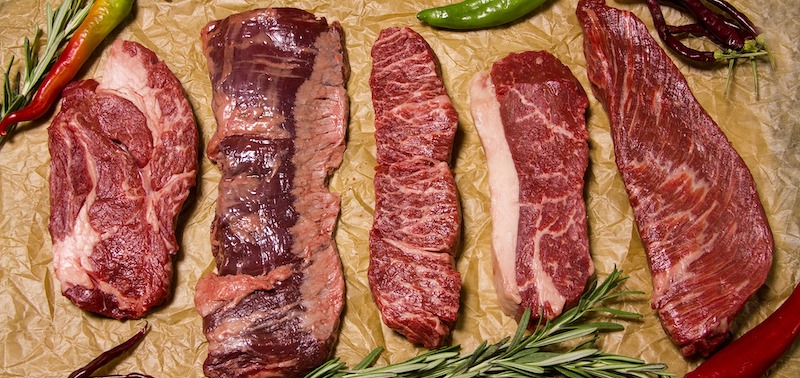I have been part of the beef industry for a while now, but honestly, I have never been great with cuts of beef. It’s a whole part of the industry that, as a producer, I have yet to master, and seems so difficult to remember! There are butcher cuts, region-specific cuts, foodservice cuts, and so many different views on how the cuts are made, or what they are called. It’s truly an art to understand the process. Of course, I know the more common cuts and the best ways to prepare them, like ribeye, New York, and tri-tip, but some cuts aren’t as common on the grocery store shelves. As a future direct-to-consumer beef rancher, I want to make sure I know the lesser-known cuts and be able to communicate what I want with my butcher and tell the customers all about the cuts they are buying from me.
For the next few months, I will be breaking down the cuts of beef and help you learn more about each cut, how to prepare it, and fun facts about them. Be sure to check out the first part of this series in March’s MJDOA Magazine issue.
After last month’s piece, we now know that the beef carcass is broken down into eight primal cuts, which are the main areas all other cuts come from. Below is an image of the primal cuts.
These are the:
- Chuck
- Rib
- Loin
- Round
- Brisket
- Plate
- Flank
- Shank
Insert image of primal cuts from last month’s article here Photo credit Certified Angus Beef
The primal cuts are divided into the forequarter and hindquarter. According to lbsteak.com, “When a carcass is cut, they are first split down the middle into two halves. Once this is done, each individual side is divided between the 12th and 13th ribs. The two halves from the front of the cow are considered the forequarter, while the two halves from the back of the cow are considered the hindquarter.”
After the primal cuts, there are subprimal cuts. But, it doesn’t stop there. From the subprimal cuts, there are individual cuts that can be cut down even further.
Continuing on with our series, we are going to focus on the Rib cuts this time around. Descriptions are courtesy of Certified Angus Beef. Be sure to head to certifiedangusbeef.com for more information.
Of course, one of the most common cuts you may find from this part of the animal is the ribeye. Known for its flavorful taste and marbling, it’s a staple in most beef-lover’s diets.
The rib cut, sclydeweaver.com states, “consists of the sixth through the 12th ribs, not including the lower portion, which is known as the plate.Because the beef rib section is tender and flavorful, these cuts are versatile, and you can cook them to perfection in many different ways.”
Sclydeweaver.com also explains the two subprimal cuts from the rib area:
- Ribeye Roll: The ribeye roll includes ribeye steaks and roasts, all of which are rich, juicy and tender. The best ways to prepare ribeye roasts are through roasting or baking, and there are a variety of ways to prepare steaks, including grilling, pan-broiling, smoking and more. Ribeye steaks and roasts are a favorite cut of meat for their delicious flavor and succulent texture.
- Rib Subprimal: This subprimal cut includes back ribs, short ribs and rib oven-prepared, all of which are tender, delicious ribs. As the name suggests, rib oven is best roasted, while there are a variety of ways to prepare back ribs and short ribs. This subprimal also includes rib fingers and blade/lifter meat.

RIBEYE
Common Names: Delmonico Steak, Filet of Ribeye
Description: This boneless steak is rich, tender, juicy and full-flavored, with generous marbling throughout.
Cooking Methods: Grill, Sous Vide, Stir Fry and Saute
And, something that is a Christmas classic with my family? The prime rib. It is seriously amazing.
PRIME RIB
Common Names: Ribeye Roast
Description: Rich flavor, juicy tenderness and majestic appearance. The grand champion of beef roasts. One of the most tender beef cuts. Fine-grained with generous marbling throughout.
Cooking Methods: Roast
RIB FILET
Common Names: Filet of Rib, Rib Filet
Description: Boneless ribeye steak with the cap removed. Rich, beefy flavor and generous marbling.
Cooking Methods: Grill
Stir Fry and Saute
BONELESS RIBEYE ROAST
Common Names: Prime Rib
Description: A rib roast without the bones. Rich, beefy flavor; juicy and tender with generous marbling throughout.
Cooking Methods: Roast
My personal favorite, theTomahawk steak. It is such a cool looking cut and provides some drama when presented on a plate!
COWBOY STEAK
Common Names: Bone-in Ribeye, Rib Steak Bone-In, Tomahawk Steak
Description: Rich, juicy and very flavorful, with generous marbling throughout. A cowboy steak has a short frenched bone; the tomahawk, a long frenched bone.
Cooking Methods: Grill, Stir Fry and Saute
BONE-IN RIBEYE
Common Names: Rib Steak, Ribeye
Description: A rib steak that is fine-grained and juicy. Rich, beefy flavor and generous marbling throughout. One of the most tender beef cuts.
Cooking Methods: Broil, Grill, Stir Fry and Saute
BONE-IN PLATE SHORT RIBS
Common Names: Chuck Short Ribs, English Short Ribs, Plate Short Ribs, Rib Short Ribs, Ribs
Description: May be bone-in or boneless. Very flavorful, moist and tender when braised.
Cooking Methods: Braise, Slow Cooker, Sous Vide
BACK RIBS
Common Names: Ribs
Description: Back ribs are flavorful, and great when cooked on the grill.
Cooking Methods: Braise, Grill, Smoke
CHEF-CUT RIBEYE*
Common Names: Chef-Cut Ribeye
Description: Typically prepared with the bone in. Fat is removed and the cut is tied; also prepared boneless.
*This cut doesn’t have any cooking methods or recipes on the website.
Stay tuned for next month’s beef cut all about the loin area!







